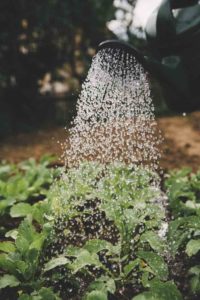All plants, from the tallest to the smallest, start out in this life small with specific needs to their own survival in order for them to grow. Many processes are involved as there are over 400K species in the green space around the world.

Take away only one element necessary for life, like water, and the plant will struggle and in the end, die. It’s up to you to provide the necessities it needs to grow and be fruitful.
The Roots Is Where It Begins
In order to deliver what a plant needs, it’s important to know how plants grow and blossom. Essentially all plants are comprised of the same features. Of course, they have roots, stems, leaves, flowers, fruits, and they also have a vascular system.
The way a plant’s system works is similar to how a human’s circulatory system works. Think of the veins and arteries and their functions. They perform the indispensable task of transporting nutrients and water through a plant.
Then there is xylem that moves water and nutrients up from the roots. On the other end of the spectrum, phloem transfers carbohydrates down from the leaves to the plant’s roots.
The Purpose Of a Root System
Roots are almost always covered in soil and their job is to support and anchor the plant. They also have the vital task of absorbing water and nutrients in order for the plant to remain healthy.
The 2 types of roots to take note of are anchoring and fibrous. The difference between the two lies in their function. The job of the anchoring roots operates to hold the plant in position in the soil and can often time store carbohydrates. Their appearance is also one that is described as thick.
Fibrous roots are the second type of root and they consist of fine roots that spread matlike from the top of the plant. They are also known for staying close to the soil surface. What sets the fibrous roots apart is that they do an excellent job of catching water before it penetrates the soil.
What you will notice is that the tips of actively growing roots are comprised of root hairs. What is interesting about these hairs is that they are almost invisible yet they are the absorptive tissue of the roots.
They help the roots take up over 500-700 times more water than they otherwise wood without them. Having these minuscule root hairs helps increase water and nutrient absorption.
Roots With a Special Purpose
There are numerous plants that have specialized roots that are miraculously adapted to the growing conditions in which the plant lives.
Roots That Grow Above The Surface
Also known as aerial roots, these grow above the soil and contribute extra support for the plant. An example of this type of root can be seen in palm tree ivy and corn. Of added interest, the roots of tropical trees can actually take in moisture from the air around them.
Unexpected Roots
Roots that grow in unexpected places are called adventitious roots. If you look closely at grasses, you’ll see that roots will develop where a stem simply comes in contact with the ground. It’s fascinating. (You can read more about this in this landscaping article.
Carbohydrate Storage Roots
The name of these roots gives away their purpose. The roots actually store the plant’s food, carbohydrates, to use down the road. Many plants have storage roots. A more popular one is carrots.
Healthy Roots
Roots that fall under this classification need water in order to grow. They are not aggressive enough and will not grow through the soil to find the water or oxygen the plant needs.
Overwatering the garden which can cause waterlogging to occur as well as compact soil has little oxygen. Without the necessary oxygen, these roots naturally die.
Other Root Growth Factors
There are more than just water and oxygen required for root growth. Salts, soil texture, as well as soil temperature, also play a key role. The ideal environment for growth is when the soil temperatures range from 4 degrees Celsius and 10 degrees Celsius.
The great thing about salt is that it will appear naturally in soil. You can also ensure salt is in the soil by fertilizing since it’s a byproduct.
As you can imagine, the salt will hold onto the water it comes into contact with. The problem is when the amount of salt in soil is unreasonable, it is then that plants have trouble taking up moisture.
Another aspect that creates a tough environment for root growth is soil texture. It doesn’t take much imagination to see that roots grow quickly in soil with a light texture. If the soil is compacted, the roots will simply not grow as effectively.
If this gardening information is overwhelming, read this landscaping article about how to hire a professional to help you.
Roots That Are Pruned
When it comes to pruning a root and a stem you will get different results. If a stem is cut it will develop many new stems from buds below the cut. They actually branch out and grow thicker.
On the other hand, when cutting a root, new roots may appear at any point along the remaining root. However, you can be assured that they are when they do appear they will be closer to the cut end.